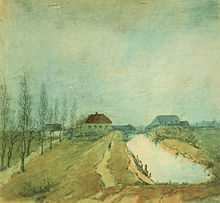Turks Trench


The Türkengraben was a temporary canal in Munich that gave today's Türkenstrasse its name.
history
The builder of the Turks Trench was the Elector Max Emanuel (1662–1726). The aim was to connect the Munich residence with the new palace in Schleissheim . The electoral geometer Mathias Paur planned the canal in 1701, and construction began in May 1702.
The canal was dug by soldiers of the electoral infantry. A rumor later developed that Turkish prisoners of war were also involved in the work. This was not correct as the Turkish prisoners of war from the Great Turkish War had already been exchanged by 1699, but it led to the name Turkish Trench .
In 1704 work on the canal was stopped. At that time, the first section of the canal from the Munich Residence to the confluence with the Nymphenburg-Biederstein Canal was completed. The northern end was near the current intersection of Belgradstrasse and Petuelring . The dry-lying canal was filled in from 1811 and partly built over. Today the direction of the canal is indicated by Fürstenstrasse, Nordendstrasse, Kurfürstenstrasse and Belgradstrasse.
Honor
In Munich's Schellingstrasse at the corner of Türkenstrasse, five windows by the artist Joachim Jung set into a wall are reminiscent of the Turks ' Trench. The windows were funded by the Street Art Foundation of the Stadtsparkasse München and inaugurated in 2005.
Web links
Individual evidence
- ↑ cf. Christine Rädlinger: History of the Munich city streams, ed. from the Munich City Archive, Franz Schiermeier Verlag Munich, 2004, ISBN 978-3-9809147-2-7 , p. 185
- ↑ http://web.archive.org/web/20061005050731/http://www.sskm.de/sskmwww/sskmwww_prod/sskmwww/presse/textarchiv/2005/20051215_01.jsp
